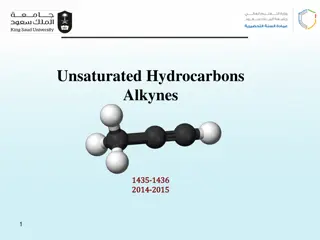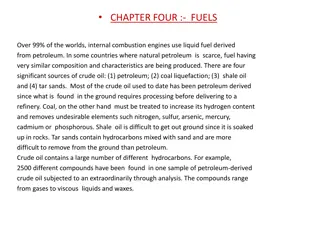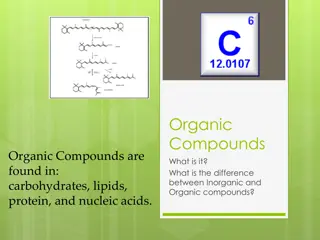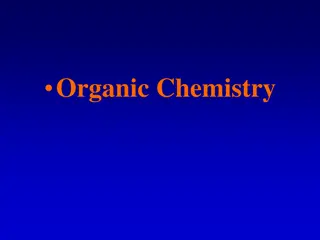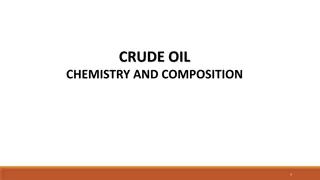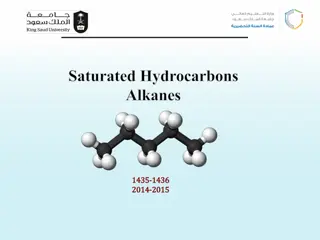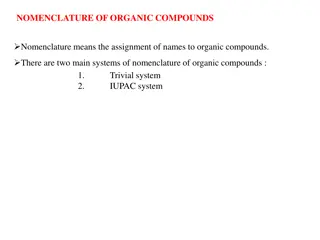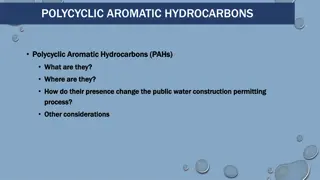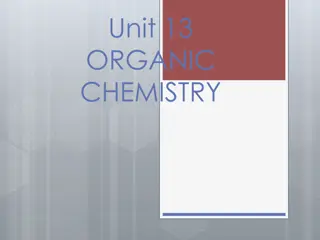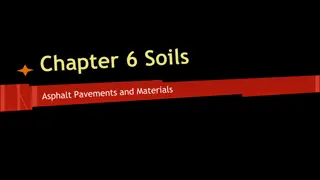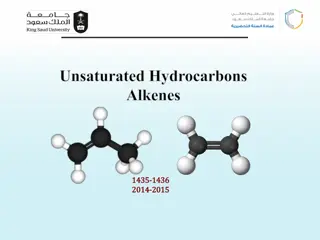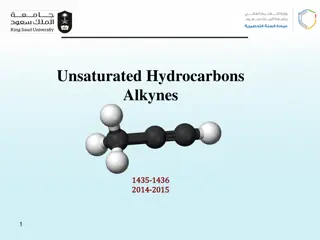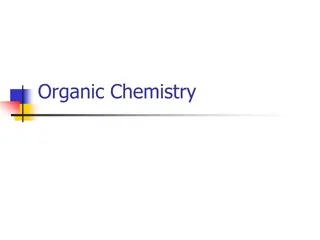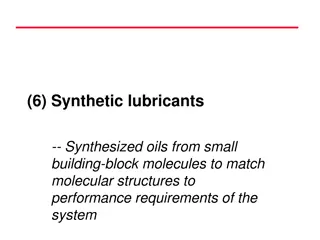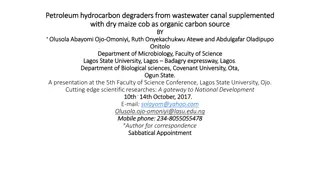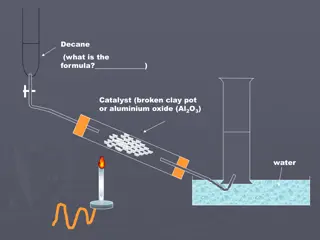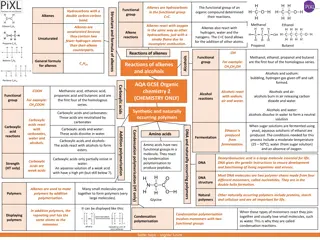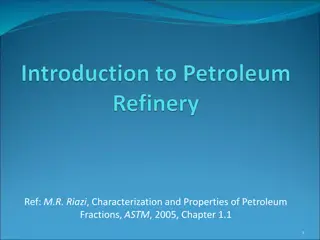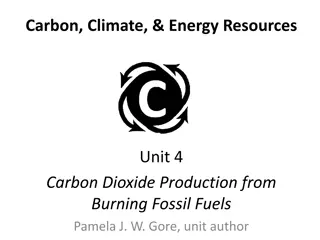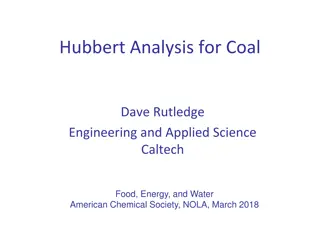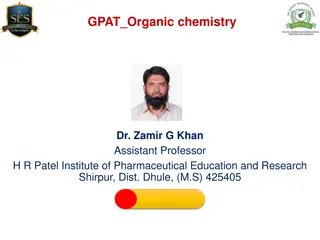Unsaturated Hydrocarbons Alkynes
Chapter three delves into the world of alkynes, focusing on their structure, hybridization, bonding, nomenclature, physical properties, preparation, and reactions. Alkynes are hydrocarbons with at least one triple bond, forming a homologous series with the molecular formula CnH2n-2. The sp hybridiza
0 views • 20 slides
Understanding Fuels and Their Sources
Fuels derived from petroleum, coal, shale oil, and tar sands are crucial for powering internal combustion engines. Crude oil contains various hydrocarbons requiring refining processes to obtain products like natural gas, gasoline, kerosene, diesel oils, fuel oils, and lubricating oils. The chemical
1 views • 7 slides
Understanding Organic Compounds and Their Importance in Daily Life
Explore the world of organic compounds, including their definition, difference from inorganic compounds, common elements found in them, and the significance of hydrocarbons. Learn about the essential role of organic compounds in living organisms, such as proteins, carbohydrates, and fats, and how th
1 views • 51 slides
Understanding Organic Chemistry and Hydrocarbons
Dive into the world of organic chemistry, exploring the properties of organic compounds with carbon as the principal element. Discover the unique characteristics of carbon-to-carbon bonds, different types of hydrocarbons, and the structures formed in this fascinating branch of chemistry.
2 views • 60 slides
Understanding the Chemistry and Composition of Crude Oil
Crude oil, also known as petroleum, is a complex mixture of hydrocarbons and other compounds like sulfur, nitrogen, and metals. The composition of crude oil includes aliphatics, aromatics, naphthenes, and other elements, each playing a unique role in its properties and characteristics. This article
1 views • 12 slides
Understanding Alkanes: Properties, Structures, and Nomenclature
Alkanes are saturated hydrocarbons containing only single bonds. This chapter covers the classification, general formula, naming conventions, molecular structures, hybridization, and reactions of alkanes. Explore the unique characteristics of alkanes, including their physical properties, cycloalkane
0 views • 44 slides
Overview of Organic Compounds Nomenclature
Nomenclature of organic compounds involves assigning names based on two main systems - Trivial system and IUPAC system. Trivial system utilizes names related to discoverers or sources, often with Latin or Greek roots. Saturated hydrocarbons, known as paraffins, contain single bonds and are less reac
0 views • 27 slides
Understanding Polycyclic Aromatic Hydrocarbons (PAHs) and Their Impact
Polycyclic Aromatic Hydrocarbons (PAHs) are ubiquitous environmental pollutants found in nature and from human activities like combustion. They affect public water construction permitting processes by influencing material standards. PAHs can be harmful concerning health when soils are disturbed duri
0 views • 6 slides
Exploring Organic Chemistry Fundamentals
Delve into the world of organic chemistry, understanding the nature of organic compounds, the unique attributes of carbon, and the properties of these compounds. Discover the significance of molecular, structural, and condensed formulas, along with insights into hydrocarbons and the concept of homol
4 views • 56 slides
Understanding Alkanes: Structure, Properties, and Nomenclature
Explore the world of alkanes, saturated hydrocarbons with single bonds. Learn about their classification, molecular formulas, naming conventions, physical properties, and methods of preparation and reactions. Discover the hybridization of carbon in alkanes and delve into the different classes of car
0 views • 44 slides
Understanding Asphalt Binders in Pavement Construction
Asphalt binders play a crucial role in pavement construction, composed of three types of hydrocarbons: asphaltenes, resins, and oils. Different types of asphalt cements are produced for specific applications, such as liquid asphalts and asphalt emulsions. Quality control tests ensure the performance
0 views • 16 slides
Nomenclature of Bridge Compounds in Organic Chemistry
Understanding the nomenclature of bridge compounds is essential in organic chemistry. This involves defining bridge heads, bridges, main ring selection, main bridge heads, main bridges, secondary bridges, and more. The IUPAC nomenclature of bridge systems includes indicating the number of rings usin
0 views • 9 slides
Understanding Alkenes: Structure, Bonding, and Naming
Alkenes are unsaturated hydrocarbons containing a C=C double bond. This chapter covers topics such as alkene structure, hybridization, naming, isomerization, physical properties, preparation methods, stability rules, and addition reactions. Learn about the sp2 hybridization of orbitals in alkenes, o
0 views • 38 slides
Understanding Alkynes in Organic Chemistry
Alkynes are unsaturated hydrocarbons with at least one triple bond, following a molecular formula of CnH2n-2. This group of compounds is discussed in Chapter three, covering topics like structure, hybridization, common naming, physical properties, preparation, and reactions. The sp hybridization of
1 views • 20 slides
Aromatic Hydrocarbons: Structure, Aromaticity, and Nomenclature
Aromatic hydrocarbons, with benzene as a key example, possess unique properties due to their highly unsaturated structures. The molecular formula of benzene is C6H6, and it exhibits resonance through a planar structure with sp2-hybridized carbons. To be classified as aromatic, a compound must have a
0 views • 19 slides
Exploring the World of Organic Chemistry
Organic chemistry delves into the study of carbon compounds beyond just living organisms. With carbon's unique bonding capabilities, a vast array of useful compounds are created naturally and synthetically, shaping the foundation of modern chemistry. From hydrocarbons to complex structures like DNA
0 views • 34 slides
Understanding Organic Chemistry: Carbon Atoms and Molecular Diversity
In organic chemistry, carbon atoms can form diverse molecules by bonding to four other atoms, leading to molecular complexity and diversity. The versatile nature of carbon allows for the formation of various carbon skeletons, contributing to the vast array of organic compounds. Hydrocarbons, consist
0 views • 12 slides
Lean Oil Absorption Process in Gas Processing
The Lean Oil Absorption process in gas processing involves using hydrocarbon-rich lean oil to absorb heavier hydrocarbons from natural gas, allowing for increased gas condensate recovery. This method is a cost-effective way to separate different products in natural gas, alongside refrigeration proce
1 views • 14 slides
Understanding Synthetic Lubricants: Components and Manufacturing Process
Synthetic lubricants are formulated from small molecules to meet specific performance requirements. They offer advantages over mineral oils due to their tailored molecular structures. Components such as paraffins, iso-paraffins, naphthenes, and aromatics influence properties like pour point, tractio
0 views • 20 slides
Exploring Coal-to-Liquid Technology for Energy Security in India
India's abundant coal reserves present opportunities for utilizing Coal-to-Liquid (CTL) technology to convert coal into liquid hydrocarbons. The CTL process, proven and popular globally, offers a potential solution for energy security and reducing dependence on oil imports. Despite past challenges w
0 views • 12 slides
Overview of Texas Risk Reduction Program (TRRP) for TPH Environmental Impact
The Texas Risk Reduction Program (TRRP) provides guidelines for managing Total Petroleum Hydrocarbons (TPH) in environmental assessments. Different regulations and programs govern TPH analysis depending on the source, with specific methods like TCEQ Method 1005 and 1006 used for TPH analysis and det
0 views • 21 slides
Evaluation of Petroleum Hydrocarbon Degraders in Wastewater Canal Supplemented with Organic Carbon Source
This study explores the potential of native bacterial populations in wastewater for bioremediation of petroleum hydrocarbon-polluted environments. The research involved exposing Bonny light crude oil to wastewater canal samples supplemented with dry maize cob as an organic carbon source. Results sho
0 views • 26 slides
Explore Programming and Memory Concepts with Crosswords and Terms Collection
Dive into the worlds of programming, memory, and welding processes with a collection of terms and crosswords. Learn about variables, functions, languages, and types while engaging in stimulating puzzles. Discover the beauty of saturated hydrocarbons and test your knowledge with terminology related t
0 views • 5 slides
Understanding Intermolecular Forces and Dispersion Forces in Molecules
Particle diagrams of liquids, solids, and gases reflect distinct arrangements due to intermolecular forces. The existence of substances as gases, liquids, or solids at room temperature is attributed to the forces between molecules known as intermolecular forces (IMF), with dispersion forces being th
0 views • 30 slides
Understanding Alkanes and Alkenes in Organic Chemistry
Explore the properties and reactions of decane, catalysts, isomers, and addition reactions of alkenes in this comprehensive guide. Learn about saturated and unsaturated hydrocarbons and witness the transformation from alkenes to alkanes through different chemical processes.
0 views • 18 slides
Understanding Mass Spectrometry in Pharmaceutical Analysis
Delve into the intricacies of mass spectrometry as applied to pharmaceutical analysis, exploring the fragmentation processes, allylic cleavage in alkenes and alkynes, and the characterization of aromatic hydrocarbons. Discover how mass spectrometry aids in identifying and analyzing various compounds
0 views • 31 slides
Utilizing Hydrotalcites as Photo Catalysts for Carbon Dioxide Reduction
Burning fossil fuels leads to CO2 emissions, posing a significant environmental challenge. Converting CO2 into valuable hydrocarbons through photocatalytic reduction using solar energy provides a sustainable solution. This process involves multi-electron transfer steps, requiring efficient catalysts
0 views • 24 slides
Understanding Alkenes, Alcohols, and Carboxylic Acids in Organic Chemistry
Alkenes are hydrocarbons with a double carbon-carbon bond, reacting uniquely due to their functional group. Alcohols and carboxylic acids also have distinctive properties and reactions, important in organic chemistry studies. Learn about their structures, formulas, reactions with other compounds, an
0 views • 4 slides
Understanding Alkenes and Alkynes: Nomenclature, Reactions, and Preparations
Alkenes and alkynes are crucial types of unsaturated hydrocarbons with distinct characteristics. This content delves into their IUPAC nomenclature rules, preparation methods, qualitative tests, and reactions. It also explores naming conventions for alkenes and alkenyl groups, providing a comprehensi
0 views • 32 slides
Understanding Petroleum Hydrocarbons and Their Properties
Petroleum is a complex mixture of hydrocarbons, including paraffins, olefins, naphthenes, and aromatics. Paraffins are fully saturated and stable, olefins are unsaturated with double bonds, naphthenes are cyclic saturated hydrocarbons, and aromatics are cyclic unsaturated hydrocarbons containing ben
0 views • 19 slides
Understanding Fossil Fuels, Energy, and the Carbon Cycle
Exploring the relationship between fossil fuels, energy production, and carbon emissions. Learn about the carbon cycle, photosynthesis, and the impact of human activities on the environment. Delve into the extraction of hydrocarbons, coal mining, and personal experiences in petroleum production. Gai
0 views • 39 slides
Biochemistry and Chemistry Elective Courses Overview at SRCASW
The Shaheed Rajguru College of Applied Sciences for Women offers elective courses in Biochemistry and Chemistry. The Biochemistry course covers biomolecules like amino acids, proteins, carbohydrates, lipids, and nucleic acids, emphasizing their properties and functions. It also includes practical ex
0 views • 19 slides
Understanding Carbon Dioxide Emissions from Fossil Fuel Burning
Fossil fuel burning, particularly from coal and hydrocarbons, is a significant source of carbon dioxide (CO2) emissions, a greenhouse gas linked to global warming and climate change. This process results in the release of various byproducts into the atmosphere, including sulfur dioxide, nitrogen oxi
0 views • 15 slides
Gas Processing: Dew Point Control and Refrigeration Systems
Gas processing involves gathering raw gas from wells, passing it through various units like feed gas receiving, condensate stabilization, gas treating, dew point control, and refrigeration units to control liquid condensation and recover natural gas liquids. Dew point control helps prevent condensat
0 views • 26 slides
Insights into Global Energy Production Trends and Environmental Impacts
Exploring historical world energy production data, Hubbert analysis for coal, and the global carbon cycle from the IPCC 5th Assessment Report. The discussion includes the longevity of fossil fuels, the rise of hydrocarbons, per-person energy production, and the shift towards universal electricity ac
0 views • 33 slides
Introduction to Aromatic Compounds and Benzene Nomenclature
Learn about aromatic compounds, their resonance in benzene, orbital structure, nomenclature for benzenes, and different types of substituents like monosubstituted and disubstituted benzenes. Explore the stability of aromatic compounds compared to aliphatic ones and understand the nomenclature for va
0 views • 19 slides
